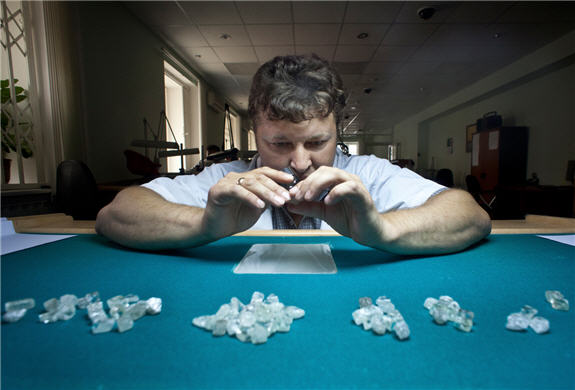Alrosa diamonds sold for an average $118.50/carat in Q1 2014
On a call with investors on June 24th, ALROSA provided figures that showed the company’s average price of rough diamonds (gem + industrial) sold in Q1 2014 was down 2.1% from Q1 2012, and up 0.5% from Q1 2013. In Q1 2014, ALROSA’s diamonds sold for an average price of $118.50/carat.

ALROSA is a Russian diamond giant that has 9 primary diamond mines, 10 alluvial mines, and 2 mines in development. Given, that ALROSA currently represents over a quarter of global rough diamond production, the company’s figures provide a good proxy for a typically opaque rough diamond market.

Breaking down the figures by gem-quality and industrial-quality diamonds:
ALROSA’s average price of gem-quality diamonds sold in Q1 2014 was down 15.9% from Q1 2012, and down 2.0% from Q1 2013. In Q1 2014, ALROSA’s gem-quality diamonds were sold for an average price of $154.60/carat.
Their average price of industrial-quality diamonds sold in Q1 2014 was up 36.4% from Q1 2012, and up 31.9% from Q1 2013. In Q1 2014, ALROSA’s industrial-quality diamonds were sold for an average price of $12.00/carat.

In terms of carats produced, gem-quality diamonds currently represent 74.8% of ALROSA’s output, which is up from 64.2% in Q1 2012. In Q1 2014, ALROSA produced 9.5M carats of gem-quality diamonds, and 3.2M carats of industrial-quality diamonds. On average in Q1 2014, ALROSA’s gem-quality diamonds sold for 11.9 times more than their industrial-quality diamonds.
Industrial-quality diamonds are most commonly used for abrasive applications such as drill-bits and saw blades, and the large majority >80% are produced synthetically primarily in India and China. The balance of industrial diamonds are produced as a by-product of gem-quality (jewelry-quality) diamond mining. Typically for a diamond mine to be economic, the majority of the value of production comes from gem-quality diamonds.
Global rough diamond production is estimated to be 126.3 million carats in 2014, which would be down 2.8% from 2013. Total value of 2014 production is estimated to be $17.8 billion, which would be up 1.7% from 2013. These year-over-year figures represent a decrease in global diamond production volume, but an increase in the diamond prices in 2014.
About the Author:
Paul Zimnisky has worked in the financial industry for over 10 years as an arbitrage trader, equity analyst, and Exchange Traded Fund creator and developer. Paul closely follows the global financial markets, gold, diamonds, and the U.S. energy industry. Paul has been interviewed and quoted by numerous financial media outlets including Bloomberg TV, Fox Business News, the Economist, Barron’s, Forbes, and Investors Business Daily. Paul graduated from the University of Maryland’s Robert H. Smith School of Business with a B.S. in Finance. Paul can be reached at PaulZimnisky@gmail.com.
More News
{{ commodity.name }}
{{ post.title }}
{{ post.date }}



2 Comments
JimQ
I read elsewhere that the losses were caused by the forex market exchanges.
Matilija
Russia has a ton of Diamond mines in the Far Eastern region http://www.cccarto.com/atlas/diamondmines/russia/index.html